If you didn’t know we were talking about gardening, Deep Water Culture may sound like something that you would need scuba gear for.
In actuality, Deep Water Culture is one of the simplest, if not the simplest, hydroponic methods of growing plants. But don’t be fooled by its simplicity, it’s one of the most effective methods of producing excellent plant yields. Just ask any of the numerous commercial growers that utilize this method.
In this article, I set out to explain everything you need to know about Deep Water Culture hydroponic systems. I will cover everything from how it works, its advantages and pitfalls, and even how to build a DIY system with readily available pieces of equipment.
What is Deep Water Culture and How Does DWC Work?
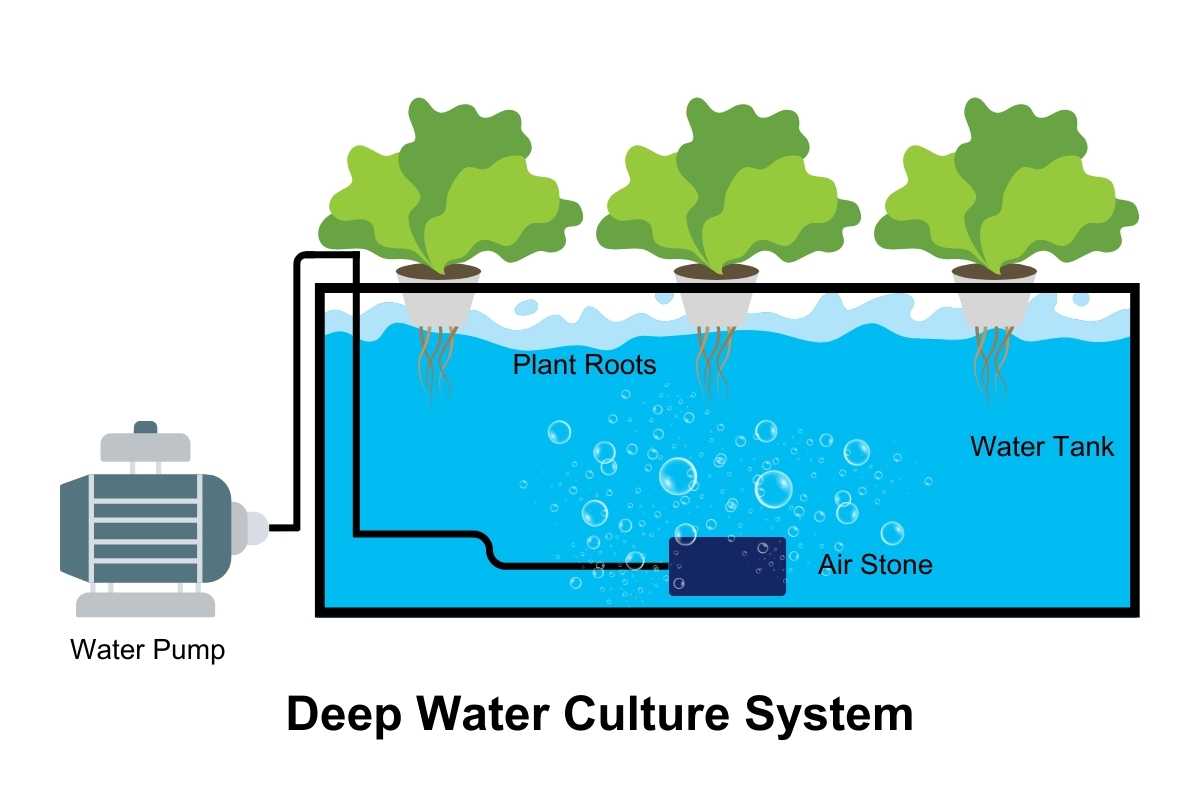
A simple overview of a Deep Water Culture (DWC) system is it is a system where a plant’s roots are suspended in a nutrient-rich reservoir of oxygenated water.
Water, nutrients, and oxygen are all critical components for healthy plant growth. In nature and traditional soil gardening, a plant will absorb all the oxygen, water, and nutrient it needs from the soil it grows in.
In DWC systems, a constant water supply of hydroponic nutrients are fed directly to the plant’s roots without the need for any growing medium, such as soil.
Let’s have a closer look at how these are delivered to the plant.
- Water – A reservoir of water with hydroponic nutrient solution sits below the plants situated in a floating raft. The reservoir water with nutrients also supplies so plant roots are able to grow in a stable environment.
- Nutrients – In traditional gardens, the nutrients are present in the soil naturally or usually added as fertilizer. Plant roots absorb nutrients from watered soil, but the water absorption is not as efficient. With DWC systems, a ready supply of well-oxygenated solution of hydroponic water nutrients is there for the roots to efficiently absorb.
- Oxygen – Without plenty of oxygen added to the water, the plants would drown. The oxygen levels in the reservoir are kept at a high level by using an air pump and air stone.
Oxygen is what could be considered the big differentiating factor between Deep Water Culture systems and other hydroponic systems, such as Nutrient Film Technique (NFT) or Ebb and Flow Systems.
In these other types of systems, the roots are partially or periodically exposed to air to allow them to breathe. In DWC systems, the roots are permanently submerged in water into which the oxygen is added.
The simplicity of Deep Water Culture setups makes it ideal for beginner hobby growers to start with. This type of gardening is low maintenance once it’s been set up. That’s one of the main advantages of deep water hydroponics gardens.
But there are also many experienced hydroponic gardeners. The DWC form of hydroponics is widely used in commercial gardens, thanks to the virtually maintenance-free nature of running them. For commercial growers, they also receive huge yields due to the quick uptake of nutrients by robust root mass growth in the oxygen-rich water.
With only a handful of components, and no nozzles or plumbing to worry about, once you have your system set up, there is very little to do to keep it running smoothly.
No expensive equipment needed either. A DWC system can be as simple as individual buckets of nutrient-rich, oxygenated water for different kinds of plants, and an air pump with a pot or mesh to grow your plants in.
- Learn more about What is a Growing Medium for Hydroponic
Popular Plants To Grow In DWC Systems
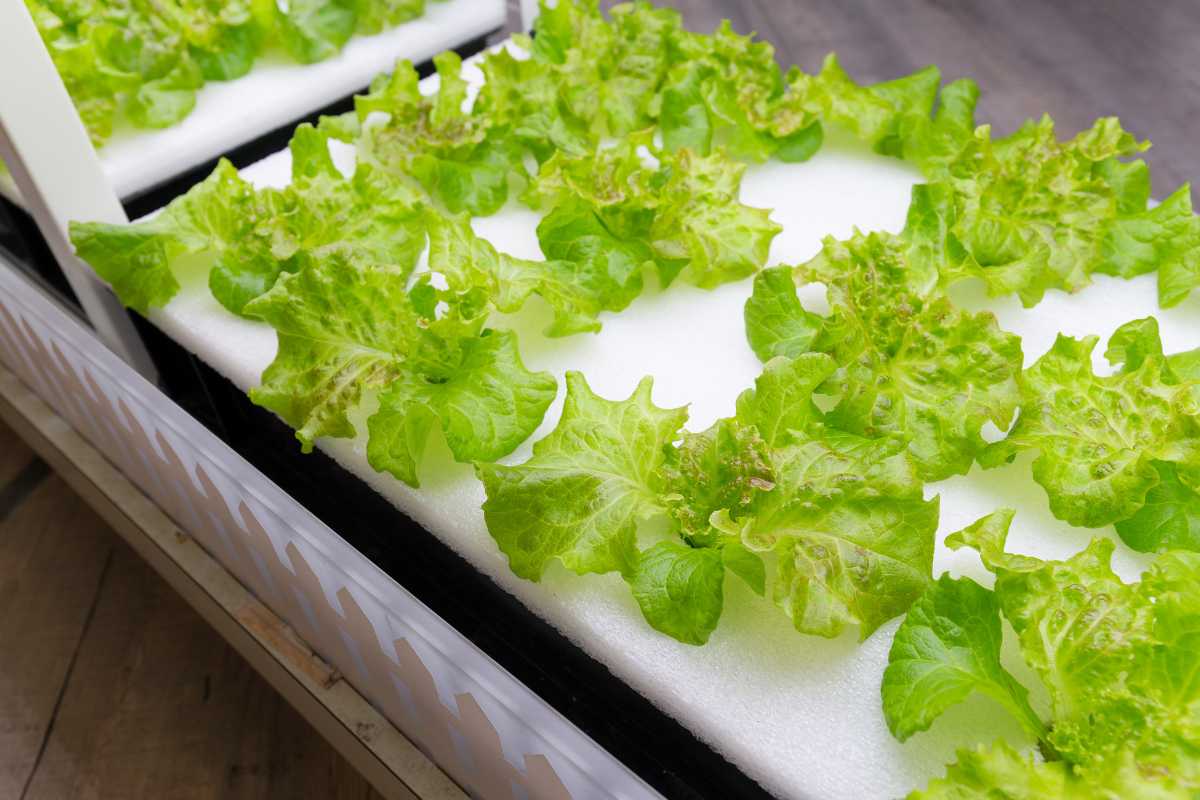
I’ve mentioned prolific plant growth with hydroponics compared to normal soil-grown plants, but there are also certain types of plants that are better for the DWC method.
You can grow plants like tomatoes and peppers and other similar types of fruits and vegetables. You do have to make sure that the plants are properly supported.
DWC systems are best for growing leafy and lightweight plants like many varieties of lettuce and herbs. But with DWC plant production, the plants are set on floating rafts.
Unfortunately, top-heavy, taller plants can tip and potentially topple the raft to one side. Those species of plants can even break at the stems without the support of a growing medium.
Let’s take a look at the most popular plants for DWC growers.
- Learn more about Hydroponic Seeds
Leafy Greens
- Lettuce
- Romaine Lettuce
- Kale
- Spinach
- Red Leaf Lettuce
- Bok Choy
Herbs
- Cilantro
- Genovese Basil
- Parsley
- Tarragon
- Thyme
- Mint
- Dill
- Chives
- Sage
Fruits and Vegetables
- Bell Peppers
- Strawberries
- Chilies
- Cherry Tomatoes
- Mini Cucumbers
I do have to say that Deep Water Culture for lettuce production is much better than growing lettuce in soil. For one, there’s no dirt to wash off on any head of lettuce. There’s also a lack of fertilizer needed, just nutrient-rich solution with plants in water. No soil also means no pests, so lettuce leaves don’t have any holes.
Learn more about growing hydroponic plants at home.
DWC Methods
While all DWC systems work on the same principle of plant roots in a large volume of water, there are some variations with Deep Water Culture for plants. In this section, we take a look at some of the more popular DWC Methods.
Traditional DWC
As the name suggests, this is the original method, and simplest. In this type of system, the roots are simply suspended in the nutrient and oxygen enriched water with an air pump, as described above.
While this is a simple method, its simplicity can at times also become its Achilles heel. The following methods are slightly more complicated and designed to correct some issues that traditional DWC systems can suffer from.
Kratky Method
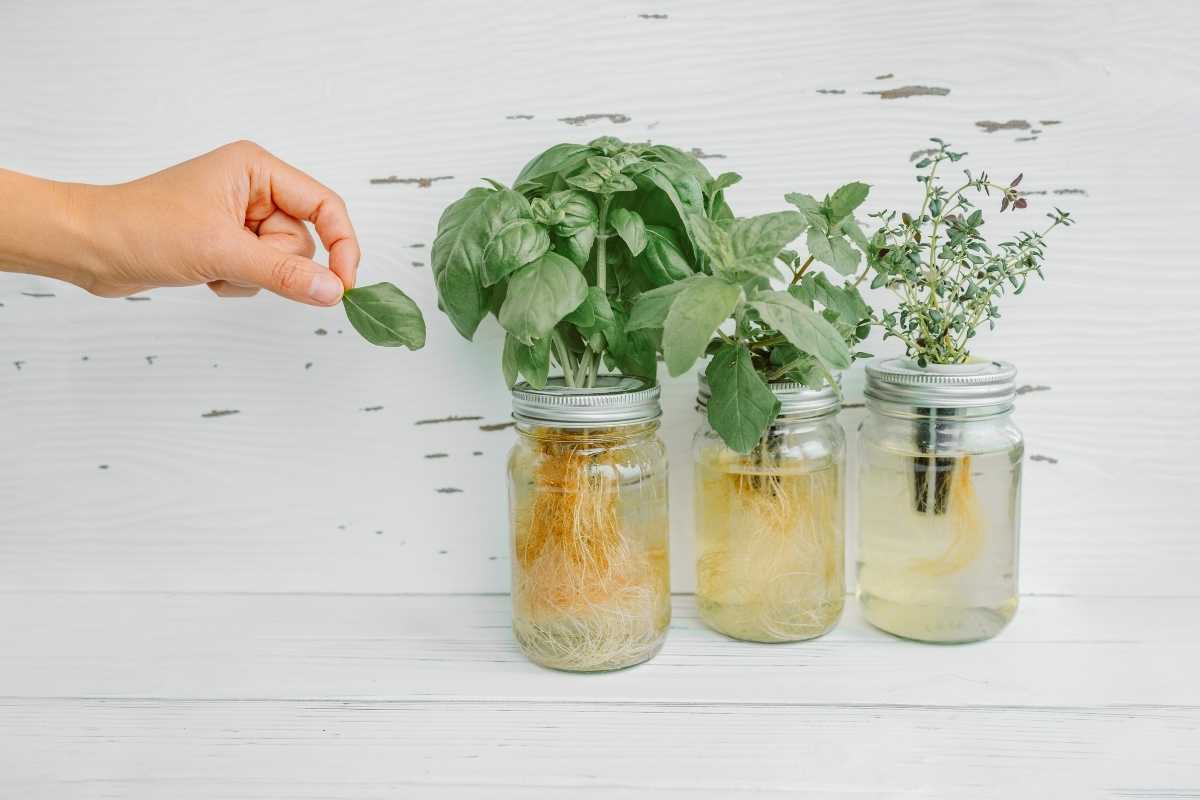
The Kratky Hydroponics System method was first proposed in 2009 by Bernard Kratky of the University of Hawaii. Some indoor growers will say that the Kratky method simplifies the traditional DWC method even further.
The Kratky method submerges only the tips of the roots in the water and nutrient solution. This method means that the roots can breathe naturally because they are also exposed to the air.
In his method, the plants are placed in net pots on boards. These are supported by beams that sit below the water. As the water diminishes the plants drop until the beams fully support them. This leaves a gap between the plant and the water which allows the visible roots to breathe.
Using this method removes any electronics and mechanics from the DWC process, and eliminates the possibility of equipment failure damaging the crop.
With the Traditional method, if you had a pump failure due to an electricity outage, the water reservoir is now full of low-oxygen nutrient solution.
Bubbleponics
Bubbleponics is a fantastic method of accelerating the germination and seedling phase of the crops. But it is of limited use after the plants become established.
Bubbleponics is a standard DWC system that adds a water pump into the mix. This pumps the water up to the net cups (aka net pots) that support the plants. It’s then distributed to the entire crop as a top-feeder system.
This has a distinct advantage in the early stages of the growing phase when it can provide nutrients to the plants before they have grown adequate root systems.
Recirculating Deep Water Culture (RDWC)
If you want to expand your existing growing system then a Recirculating DWC system could be the next step up.
Compared to a standard DWC system the methodology is identical. However, with a recirculating DWC system, you can have multiple individual growing locations linked and fed from a central reservoir.
This allows you to grow far larger crops, yet still with minimal maintenance. Setting up a recirculating system requires the following equipment.
- A central reservoir for the water and nutrients.
- A control reservoir (optional and not common in hobby systems)
- Multiple pots for your plants
- Tubing to link the pots together
- An air pump and air stone for the reservoirs and each of the plant pots
- A water pump to recirculate the nutrients throughout the system.
Of course, the once simple DWC system has now grown arms and legs, while the feeding schedule remains simple by its use of a single holding reservoir.
The main disadvantage of RDWC systems is you have more maintenance and care with pumps and tubing to feed the individual pots.
RDWC is still a relatively simple system though, and the benefits are obvious. The more pots you have, the more produce you can grow. If you are looking to start simple and potentially scale up, then these systems make it easy.
Aeration in DWC Systems
Supplying the roots with plenty of oxygen is one of the reasons that Deep Water Culture crops thrive. The direct delivery of fresh oxygen to the roots allows for superior uptake by plants.
There are a couple of common methods of oxygen delivery. In this section, I will take a look at both of these.
Air Bubbles in DWC
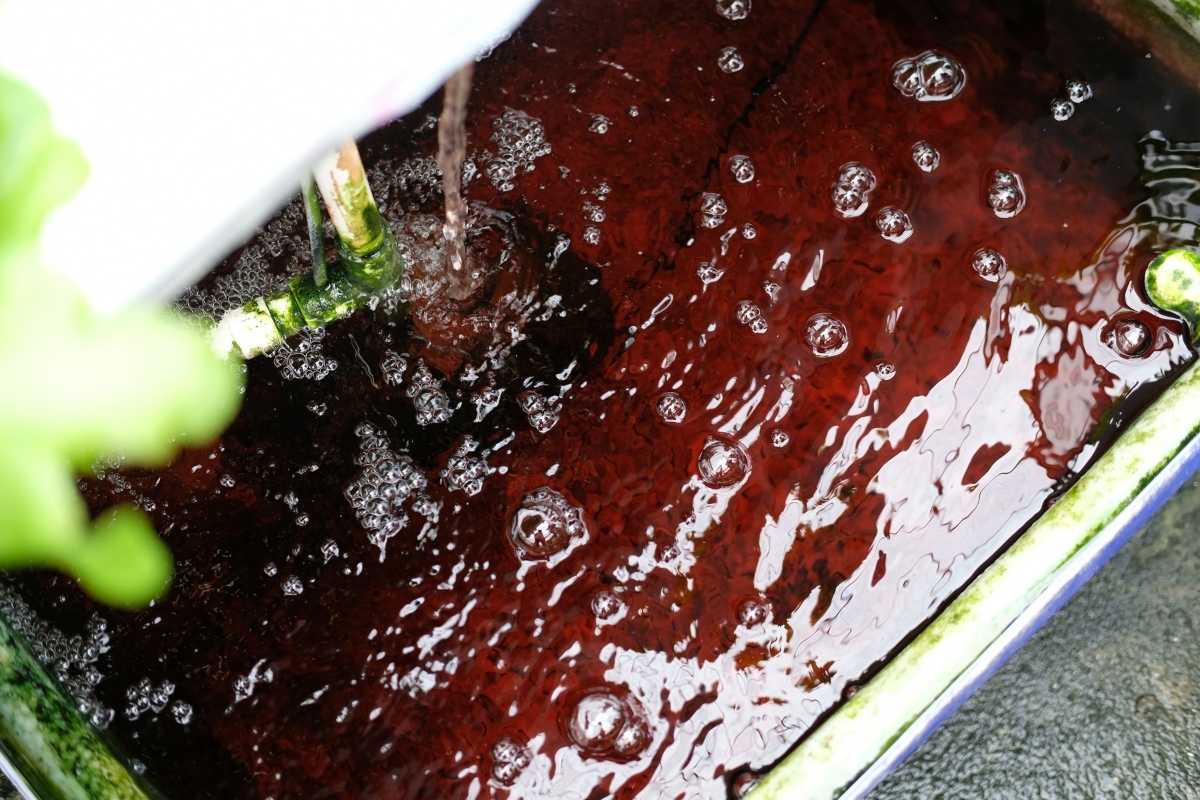
This is the most popular method of aerating DWC systems. An air pump similar to those in aquariums is typically used in this method. The air pump draws air from the atmosphere and is connected to an air stone through a tubing system.
The air stones are made from a porous, rock-like substance that is peppered with holes to disperse the air. These air bubbles rise to the top of the reservoir where they feed oxygen to the roots of the plants.
Less commonly, a soaker hose is used in place of air stones. These hoses create even smaller bubbles. The benefit that smaller bubbles provide is a more even distribution of the oxygen, by making a wider surface area of “bubbles.”
This contact between the surface of the bubbles and the water is where the oxygen transfer takes place from the air into the water.
Different types of air pumps and air stones can easily be found on Amazon.
Falling Water in DWC
This is exactly as it sounds, to understand how a falling water system works, just think waterfall!
The turmoil at the bottom of a waterfall is a rich mix of oxygen and water, and that is what this method seeks to achieve in DWC systems. In waterfalls, the higher the water falls from and the greater the amount that falls, the more oxygen is absorbed through the surface agitation.
This isn’t a method commonly used in hobby or home DWC systems. Even though it’d be great to say you have a waterfall in your home, it has some distinct disadvantages. There is the splash over and it also uses greater quantities of water than the air bubbles method.
DWC Advantages
In this section, let’s take a look at the main advantages of a DWC method of plant growing.
- Low Maintenance – There are only a few components to these systems and there are no nozzles or feeder lines that can get clogged.
- Fast Growth – With plenty of oxygen and nutrients fed directly to the root systems, the plants grow far quicker than with traditional gardening methods. It can feel like an explosion of growth one day.
- High Yields — As well as growing faster, the plants have larger yields than with soil plants. On average, hydroponic systems produce yields of between 30% and 40% greater than those grown in soil.
- Environmentally Friendly – Because the water is recycled, these systems use 95% less water than traditional methods. They also use less fertilizer and insecticides than soil-grown plants.
- Simple to set up and run – These are the great starter systems for beginner growers just getting into hydroponic systems.
DWC Disadvantages
As great as DWC is, there are still some negative factors. After all, no system is perfect. In this section, I list a few of the primary disadvantages of DWC.
- Air Pump – Although it’s rare, if the air pump breaks or there’s a prolonged power outage, plants will quickly drown, get a disease, or get root rot. It is always better to have a spare pump on standby and for larger systems, even a backup power supply is recommended.
- Disease – Because the plants are fed from a central reservoir, waterborne diseases can quickly spread through the whole crop. That can be mitigated with keeping an eye on the nutrient feeding solution and pH levels.
- Nutrient Concentration – Particularly in smaller systems, the nutrient level can fluctuate. This is also relevant to pH levels, which are also prone to fluctuations in smaller systems. It’s easier to overcorrect and under correct with smaller setups, so the levels will jump around more easily.
- Water Temperature – It’s more difficult to maintain consistent water temperatures.
DWC Feeding Plants Nutrients
Maintaining the correct nutrient levels is essential for producing healthy plants. Because the plant roots are submerged in the nutrient solution, if this is too rich, the plant roots can burn and cause a condition called Nutrient Lockout.
The nutrient needs of plants vary from species to species, as does the optimum type of nutrient to use. But as a general rule, it is best to completely change your water at least once a fortnight, this ensures there is no build-up of unused nutrients and salts in the water. At this stage, a full dosage of nutrients is added to the water following the manufacturer’s instructions.
For in-between fills, a dosage of 25% is recommended. It is important to note again that these figures vary depending on the type of nutrients you are using and the type of plants you are growing.
The important thing is to stick to the recommended levels, too high or too low a concentration can be equally harmful to a plant’s health.
How to Build a DWC Hydroponic System
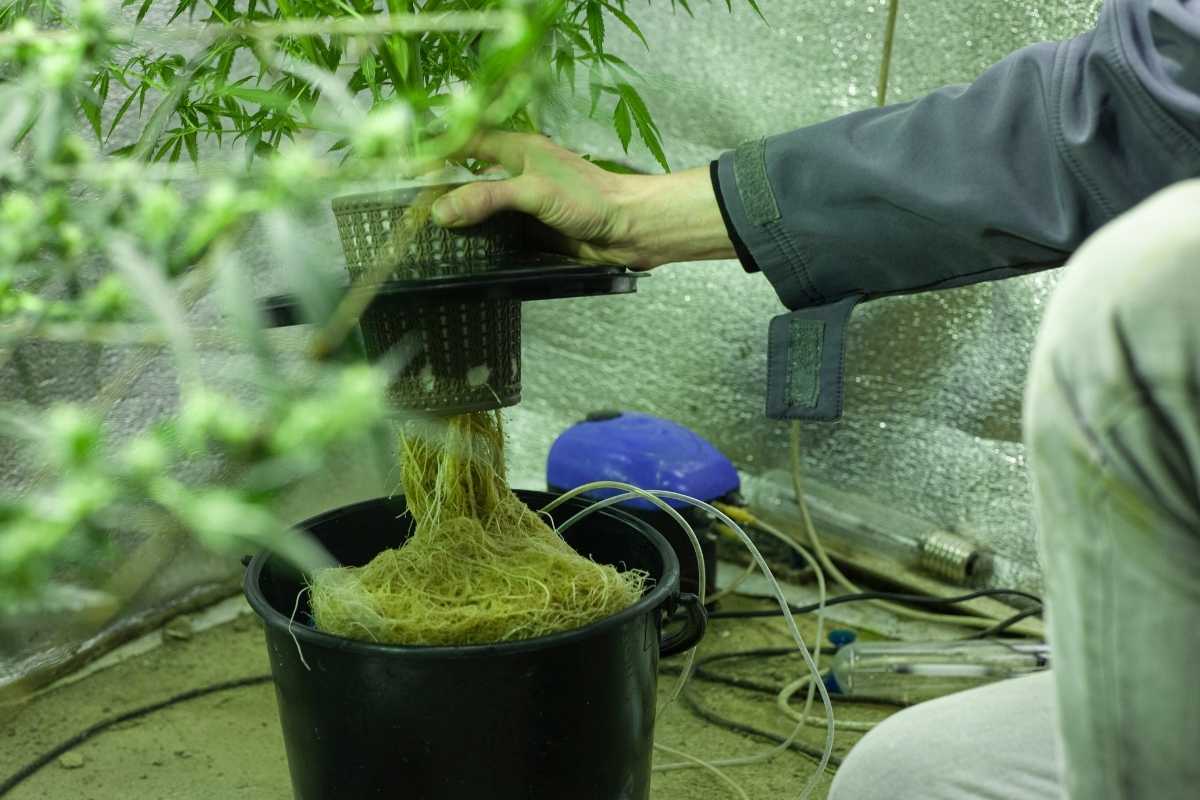
One great feature of DWC systems is that it’s possible to build one at home with just a few tools and some basic equipment. A trip to the local hardware store and pet shop will get all the equipment you need to get a DWC system up and running in no time.
What equipment you will need to buy:
- A water reservoir (this can be as basic as a five-gallon bucket)
- An air pump
- Air stone
- Tubing
- Netting or other growing medium for plants
- Plants
- Nutrients
- pH down
The method couldn’t be simpler
- Place the air pump into the bucket and using the tubing, connect it to the air stone.
- Fill the bucket with water and the appropriate amount of nutrients.
- At this stage, you should also check the pH level of your water and adjust with the pH down if required.
- Once you have germinated the seeds, place them in whichever growing mixture you have chosen and ensure that roots are in the water/nutrient mix.
- Once this stage is reached, you will see explosive growth as the abundance of aerated water, nutrients, and oxygen is fed directly to the roots of your plants.
If you add a water pump (using the Bubbleponics method), then the system can be used to grow the plants directly from seeds.
Otherwise, you will need to have a separate system for growing your plants until the root system has formed enough that it can be submerged in the mixture.
Read more about hydroponics:
DWC FAQs Frequently Asked Questions
Finally, I will answer some of the most Frequently Asked Questions about DWC Hydroponic Systems.
What Should The Water Temperature Be For Deep Water Culture?
The water temperature for Deep Water Culture systems can be one of the trickiest parts to manage. The contained system with an electric pump that generates heat means monitoring the temperature is important to ensure your plants remain in good health.
Ideally, you want to keep your water temperature between 60° F (16° C) and 68° F (20° C). When the temperature rises above 68° F, the water loses its ability to hold as much oxygen. That will stunt plant growth.
When the temperature goes below 60° F, this can trigger hormones in the plant that make them believe they are heading into winter. This can cause them to prematurely flower and not survive long.
When adding fresh water to the tank, you also want to try to maintain a constant water temperature. Look to use similar or room temperatures when adding water, so there won’t be negative plant responses.
How Often Do You Change the Water and Nutrient Solution in a DWC System?
The nutrient levels are critical for plant health, so you’ll want to change the water and nutrient solution regularly. The general recommendation is to change your water and nutrient mix at least every two weeks, and not any longer than three weeks.
This can vary depending on several factors, including:
- The size of your reservoir
- The types of plant you are growing
- The type of nutrient you are using
Between water changes, you can add nutrients to the fresh water you’ll be adding to the reservoir. This should never be more than a 25% strength mix. If you do use this then it becomes even more essential that your water is changed regularly to avoid burning the roots and potentially killing the plants.
Many novice growers have made the mistake of adding a little extra nutrient here and there on the assumption that it will make the plants grow faster. Don’t be tempted, the nutrient levels are optimized for the best possible plant growth.


